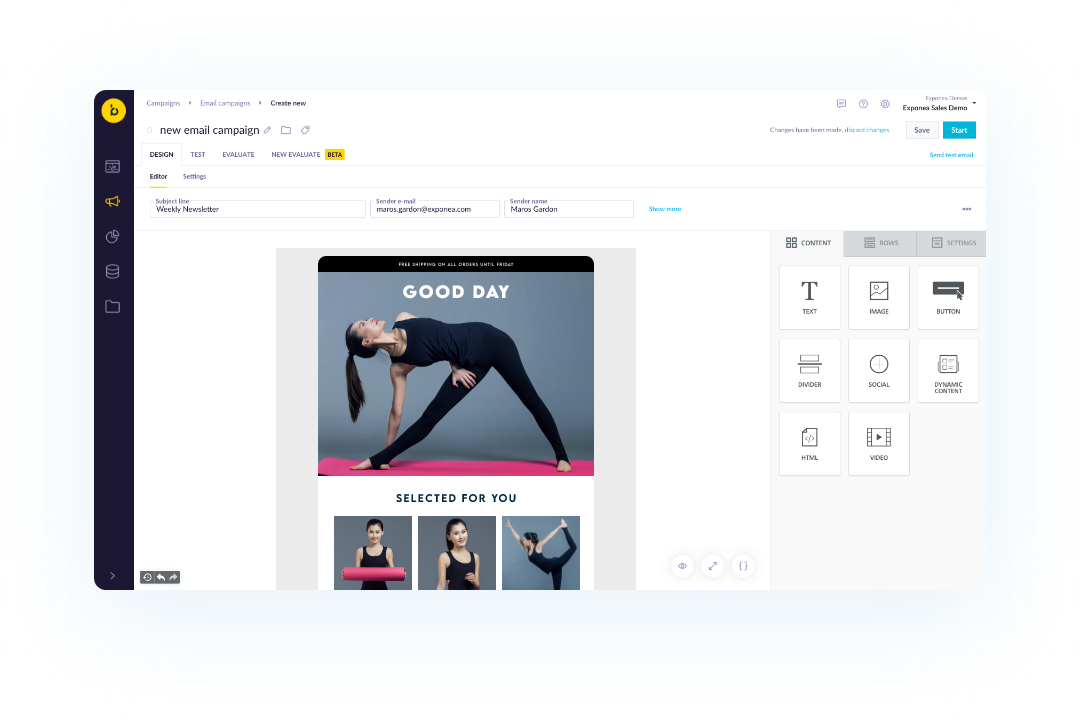How the Right Marketing Technology Makes Ecommerce Personalization a Breeze
By Carl Bleich
05/03/2022

Have you ever considered that the old adage “life is really simple, but we insist on making it complicated” might actually apply to digital commerce as well?
Focus specifically on your role as a marketer facilitating personalized experiences for your customers in ecommerce for a moment. How many times have you thought to yourself that a personalized email campaign, your personalized web pop ups, or even your retargeting efforts were just more work than they were worth? That the juice wasn’t worth the squeeze?
News flash — it doesn’t have to be so complicated. Investing in the right marketing technology solutions makes your job easier by helping you drive key metrics, alleviating how much you need to rely on IT, and just generally making your job less stressful and complicated.
But how? Ecommerce personalization has become one of many demands customers have in today’s congested digital market, and meeting those demands is essential to fostering brand loyalty. And that means a lot of hard work is on the horizon to accomplish that, right?
Well, hard work is never a bad thing. But working smart is going to get you the best results. Working with marketing technology solutions that support ecommerce personalization efforts through data collection and automation allows you to work smart. These days, your martech stack must be:
-
Able to use collected data to put it back into the hands of marketers who know what to do with it
-
Able to execute those campaigns quickly, compliantly, and without daily support from IT
-
Able to show impressive time to value to the C-suite and other business stakeholders
If your marketing technology supports those initiatives, it’s easy to unlock commerce growth with ecommerce personalization.
But you need to know more than just buzzwords and other high-level concepts that might make the CMO or CTO happy. You’re working with these solutions every day — you need to know how to facilitate these personalized experiences for customers. If you don’t do it, nobody else will.
You know what the day-to-day looks like now with your current martech stack. What could it look like with one that was centered around ecommerce personalization? Let’s dive in.
A Day in the Life With Personalized Marketing Technology
Is there any better feeling than just getting back from the grocery store and seeing your refrigerator fully stocked with every entree, dessert, snack, or drink you could possibly imagine?
What if your martech stack was always the same way, where you have everything at your fingertips to serve your customers with personalized content and experiences? If you always had all the options, what would your personalization strategy look like?
Personalized Email Campaigns
The options are nearly endless with the right martech stack in regards to personalized email campaigns.
Whether it’s starting simple with a personalized subject line, progressing to automated follow-ups, or ultimately going deep into ecommerce flows like abandoned cart or automated welcome email series, the emails your company sends to both loyal customers and first-time visitors who opt in should be personalized.
But again, you know this, you work with your marketing technology every day. How effortless you can make these campaigns is the real challenge you need to tackle.
Marketers should have full access to the data that’s collected to make personalized email campaigns as effective as possible. Without that full access — and the independence from IT to act on it (more on this later) — the data is not actionable. Marketers should be able to update their segments in real time and be able to push the right messages to the right customers because of those updates and the ability to work with real-time data.
These are all keys in ultimately producing your end goal — a personalized email campaign that generates revenue.

Experiments and A/B Testing
Imagine you could optimize conversions by modifying any website element or testing different personalization strategies directly within your marketing technology solutions. Your marketing technology solutions should afford you this ability to display unique content to each customer to offer a truly personalized experience online.
Using analytical insights and predictive data to engage with customers by segment is the wave of the future. It will drive revenue for your company, particularly if you opt to engage with your highest-value segments. But all of this starts with marketers like you having access to one very important tool — first-party data.
First-party data gives marketers the ability to pull in a customer’s first name to a headline or show a different and more relevant hero banner to a certain segment of customers. It gives you the ability to deploy an on-site birthday experience on a customer’s special day. It also opens up a world of additional possibilities for you to use ecommerce personalization tactics in a simple and effective way to drive company revenue.
Arriving at the optimal web experience by testing ideas at scale and iterating quickly is a luxury you should have in your role. Ideally, digital teams should be able to transform the visual appearance of web pages, experiment with recommendations, and test content and layout with visual editors and pre-built templates (or if you’re technically savvy, with custom coding).

Monitoring website bounce rates and improving the customer experience based on those bounce rates should be a marketing responsibility — not something you have to rely on IT to get done. A solid experimentation and A/B testing tool will give you the information needed to make data-driven decisions about nearly everything on your website. An A/B testing tool with an automated winner distribution would be even more optimal.
Maybe most importantly, your marketing technology solutions should afford you the ability to display unique content to each customer to offer a truly personalized experience online. Using analytical insights and predictive data to engage with customers by segment will drive revenue for your company, particularly if you opt to engage with your highest-value segments.

Scenarios
With the right martech stack, automated actually means automated. And it doesn’t mean having to manually update things daily or weekly to ensure that the automation is working properly.
Creating automated scenarios to connect with customers can increase their engagement and retention, or even bring back lost customers. But again, you know this, you aren’t a rookie.
Automatizing this communication to customers based on personalized custom conditions is the ideal solution. But how often does this “automatizing” involve manual work? And how much manual work? With the wrong marketing technology, that answer is too often and too much.
Scenarios should be easily creatable and editable via a simple drag-and-drop interface. Adding, removing, editing, or connecting components should be able to be done effortlessly, and after you’ve connected components, your flow should work seamlessly without the need for additional manual configuration.
If you’re not working with a simple drag-and-drop interface that can give you recommendations on how to quickly and effectively personalize campaigns, you’re working too hard. Send future-focused campaigns based on predicted actions rather than playing catch up because of out-dated data or technology.

Relying Less on IT
Did you notice something about the aforementioned features and use cases? They did not reference needing assistance from a certain other team in your organization.
Yes, we’re marketers too, so we understand — working with IT is not always easy. IT is tired of answering your questions, and quite frankly, you’re tired of asking them. Both parties are left wondering if there could be a better way. Are there marketing technology solutions available that allow them to work independently of each other on a somewhat consistent basis.
Let’s be honest — what everyone really wants to know is: Do you have a martech stack that keeps you out of IT’s hair every day?
“Time to value” is a massively important KPI in today’s market. Efficiently using your martech stack to connect commerce experiences for your customers can’t happen if the daily users of the platform are constantly needing IT assistance to do their jobs. In a perfect world, you (as a daily user of the platform) can use the data collected and unified by IT for omnichannel campaigns, email marketing, retargeting, and other key marketing automation activities without IT’s help.
Finding a tech stack that is simple to use for individuals without a technical background is a massive weight off the shoulders of the CTO and team because it frees up everybody’s time for other revenue-driving tasks and activities. But it is also a massive weight off of your shoulders as well.
It allows your time to be freed up to creative campaigns that foster brand loyalty and drive revenue rather than picking up the phone to call IT every time you need an email template created or an omnichannel campaign built.
Working independently is freedom in ecommerce. And freedom leads directly back to being able to keep things as simple as possible in the workplace.
Bloomreach Engagement — A Marketer’s Golden Ticket
Is there anything in life better than options? Or in this case, in a marketer’s day-to-day work life, is there anything better than personalization options? Whether it be personalized email campaigns, on-site personalization, or automated scenarios, your marketing technology solutions must be able to facilitate 1:1 personalization that allows your company to connect commerce experiences for your customers and foster brand loyalty.
Your best option to accomplish all of this? Bloomreach Engagement.
Bloomreach Engagement is a marketing automation and personalization solution that combines the power of a customer data platform (CDP) with native artificial intelligence, an email service provider, marketing automation, and web personalization so you can create marketing campaigns across channels that drive revenue.
You can bring all of your customer data together into a single customer view so you can deliver connected customer experiences in real time. The best part? You won’t need to constantly bug IT for help.
There’s never been a better time to increase your company’s flexibility and efficiency. As ecommerce personalization shapes the future of digital commerce, adopting an all-in-one solution that helps you scale fast and drive top-line revenue by providing 1:1 personalized experiences to your customers will have you on the cutting edge.
Interested in learning more? Watch our short video to learn exactly how Bloomreach Engagement functions and how it is specifically designed to help digital commerce companies drive revenue.
Found this useful? Subscribe to our newsletter or share it.





